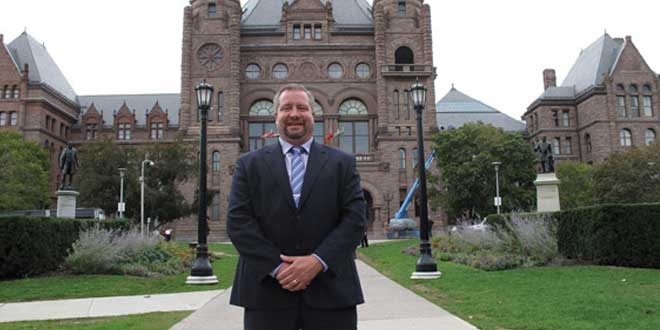NORTHERN ONTARIO—Michael Mantha, MPP for Algoma-Manitoulin, joins other Northern Ontario MPPs in voicing concerns and disappointment with the draft release of a Northern Ontario Multimodal Transportation Strategy.
“It’s most disappointing,” stated Mr. Mantha of the strategy. “It is not a true reflection of what came out during consultation with the province.”
“One big part is it is missing mention of rail transportation totally, and what is proposed for this type of transportation. This is not reflected in there,” said Mr. Mantha.
“I will be encouraging municipalities and First Nations to make their feelings known and see if we can influence the province to making some changes in the strategy,” said Mr. Mantha. “I’m very frustrated with the lack of vision this government has for Northern Ontario.”
Mr. Mantha acknowledged, “in the strategy there are some ideas and things I think we would be able to work with for the government to put in place. But with the cuts and losses for Ontario Northland, busing and rail transportation, it is making it more difficult for Northern Ontario residents to get to other places for such important things as appointments to hospital and with doctors. It is making it more difficult for people in Northern Ontario to get to needed destinations.”
More than six years after promising a strategy to create an integrated transportation infrastructure system for Northern Ontario, the Kathleen Wynne government finally released their draft Northern Ontario Multimodal Transportation Strategy, said Norm Miller, MPP for Parry Sound-Muskoka and opposition critic for Northern Development and Mines. He pointed out this strategy was promised in the Northern Ontario Growth Plan released in March 2011.
“If it takes them six years to write a draft strategy, imagine how long it will take them to actually build a road or fulfill any of the 37 promises found in this document,” said Mr. Miller. “The goals and directions listed in this document all sound good. But it is all words and no action-and we know what this government’s words are worth.”
Mr. Miller said the strategy’s goals are good, such as goal four, which says, anticipate and respond to economic, technological, environmental and social change to link people, resources and businesses. “If this government had anticipated and responded to the opportunities in the North, they would have started to build roads or rail to the Ring of Fire years ago.”
“The promises sound great but I caution Northerners to read this carefully. While the government is saying the things many people want to hear, there are caveats like four-lane or twin segments of the Trans-Canada Highway,” said Mr. Miller.
Since the Northern Growth Plan was released in 2011, the population of Northern Ontario has declined by 10,000 and both part-time and full-time jobs have been lost,” said Mr. Miller. “Northern Ontario needs a real commitment all the time, not just when an election is looming.”
Other opposition party members have been speaking against the strategy. New Democrat party MPP John Vanthof, of Timiskaming-Cochrane, said there are a lot of good ideas in the strategy. “Unfortunately, all these things are the exact opposite of what we’ve seen in the past five years,” he said in a release. He said many of the draft’s goals-such as reinvigorating passenger rail service where appropriate and fly in the face of past decisions of the Liberal government, which cancelled the Northlander passenger train several years ago.
The draft strategy is aimed at guiding transportation policy in Northern Ontario for the next 25 years, but Mr. Vanthof says there are improvements that can be made immediately. And he questions if the draft document is simply another piece of “electioneering.” He feels the province needs to look at what they can do right now.
Some of the other goals of the strategy include: establishing a network of core inter-community passenger bus services to connect the North’s major centres; four-laning, or twinning, segments of the Trans-Canada Highway to improve reliability of travel; increasing market access to rail and marine modes for freight transport, where appropriate, and supporting and enhancing municipal airports roles in helping to deliver important public services, connecting people and moving goods.
Nipissing MPP Vic Fedeli notes the strategy was promised by the Liberal government six years ago as part of the Northern Ontario Growth Plan.
The province is currently seeking public input on the transportation strategy. The draft, outlines a vision and goals for Northern Ontario’s transportation system, as well as actions to address the challenges faced by the region across all modes of transportation, including air, rail, road and marine.
“Our government is committed to ensuring a safe and efficient transportation network exists across the province, and especially in Northern Ontario,” Transportation Minister Steven Del Duca said in a statement. “We know that there are unique challenges that people in the North face, whether you live in Kapuskasing, work in Sault Ste. Marie, or attend school in Thunder Bay. I encourage you to share your feedback on our draft strategy and help us develop a plan to improve the transportation system for today and tomorrow in Northern Ontario.”
The strategy outlines five goals, said Mr. Del Duca: increase and modernize transportation options to support everyday living and economic activity in Northern Ontario, enhance traveller safety and system reliability and minimize travel delays and complications, work with remote and Far North communities to address unique transportation needs with more reliable connections between communities and to the all-season ground transportation network, anticipate and respond to economic, technological, environmental and social change to link people, resources and businesses; create a cleaner and more sustainable transportation system in Northern Ontario by reducing GHG and other environmental and human health impacts.
The strategy proposes expanding cell service across the transportation network and introducing more rest areas and pull-offs. The strategy also proposes improving airport infrastructure and enhancing the quality of winter roads, but also suggests the expansion of the all-season road network “in partnership with interested First Nation communities and other levels of government and partners.”
Residents and businesses in Northern Ontario are being encouraged to provide feedback, via an on-line questionnaire, between July 12 and September 15. A final, more-detailed action plan is slated to be released by the end of 2017.
The draft can be viewed at www.nomts.ca. Feedback is being collected at feedback.nomts.ca/477488 until September 15.




